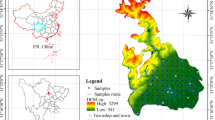Abstract
This study examined the capability of remotely sensed information gained using the terra moderate resolution imaging spectroradiometer (MODIS) normalized difference vegetation index (NDVI) and land surface temperature (LST) to explain forest soil moisture. The soil and water assessment tool (SWAT) was used for the analysis. Nine years (2000–2008) of monthly MODIS NDVI and LST data from a 2,694.4 km2 watershed consisting of forest-dominant areas in South Korea were compared with SWAT simulated soil moisture. Before the analysis, the SWAT model was calibrated and verified using 9 years of daily streamflow at three gauging stations and 6 years (2003–2008) of daily measured soil moisture at three locations within the watershed. The average Nash–Sutcliffe model efficiency during the streamflow calibration and validation was 0.72 and 0.70, respectively. The SWAT soil moisture showed a higher correlation with MODIS LST during the forest leaf growing period (March–June) and with MODIS NDVI during the leaf falling period (September–December). Low correlation was observed in the year of frequent rains, regardless of the leaf periods.






Similar content being viewed by others
Explore related subjects
Discover the latest articles and news from researchers in related subjects, suggested using machine learning.References
Arnold JG, Srinivasan RJ, Muttiah RS, Williams JR (1998) Large area hydrologic modeling and assessment part I: model development. J Am Water Resour Assoc 34(1):73–89
Carlson TN (2007) Review: an overview of the ‘‘triangle method’’ for estimating surface evapotranspiration and soil moisture from satellite imagery. Sensors 7:1612–1629
Farrar TJ, Nicholson SE, Lare AR (1994) The influence of soil type on the relationships between NDVI, rainfall, and soil moisture in semiarid Botswana: II. NDVI response to soil moisture. Remote Sens Environ 50(2):121–133
Hong WY, Park MJ, Park JY, Park GA, Kim SJ (2010) The spatial and temporal correlation analysis between MODIS NDVI and SWAT predicted soil moisture during forest NDVI increasing and decreasing periods. KSCE J Civil Eng 14(6):931–939
Huang C, Li X, Lu L (2008) Retrieving soil temperature profile by assimilating MODIS LST products with ensemble Kalman filter. Remote Sens Environ 112(4):1320–1336
Hwang TH, Kim BS, Kim HS, Seoh BH (2006) The estimation of soil moisture index by SWAT model and drought monitoring. Korean Soc Civil Eng 26(4B):345–354
Narasimhan B, Srinivasan RJ, Arnold JG, Luzio MD (2005) Estimation of long-term soil moisture using a distributed parameter hydrologic model and verification using remotely sensed data. Am Soc Agric Eng 48(3):1101–1113
Nash JE, Sutcliffe JV (1970) River flow forecasting through conceptual models part I: a discussion of principles. J Hydrol 10(3):282–290
Neitsch SL, Arnold JG, Kiniry JR, Williams JR, King KW (2002) Soil and Water Assessment Tool: theoretical documentation, Version 2000. TWRI Report TR‐191, Texas Water Resources Institute, College Station, Texas
Nemani RR, Pierce L, Running SW, Goward S (1993) Developing satellite derived estimates of surface moisture status. J Appl Meteorol 32:548–557
Sandholt I, Rasmussen K, Andersen J (2002) A simple interpretation of the surface temperature/vegetation index space for assessment of surface moisture status. Remote Sens Environ 79:213–224
Wan Z, Zhang Y, Zhang Q, Li ZL (2002) Validation of the land surface temperature products retrieved from Terra Moderate Resolution Imaging Spectroradiometer data. Remote Sens Environ 83:163–180
Wan Z, Wang P, Li X (2004) Using MODIS land surface temperature and normalized difference vegetation index products for monitoring drought in the southern Great Plains, USA. Int J Remote Sens 25(1):61–72
Acknowledgments
This study was supported by the Center for Aquatic Ecosystem Restoration (CAER) of the Ecostar project from the Ministry of Environment (MOE), Republic of Korea (MOE; EW-55-12-10), and the National Research Foundation of Korea (NRF) grant funded by the Korea government (MEST) (No. 2013-065006).
Author information
Authors and Affiliations
Corresponding author
Rights and permissions
About this article
Cite this article
Park, JY., Ahn, SR., Hwang, SJ. et al. Evaluation of MODIS NDVI and LST for indicating soil moisture of forest areas based on SWAT modeling. Paddy Water Environ 12 (Suppl 1), 77–88 (2014). https://doi.org/10.1007/s10333-014-0425-3
Received:
Revised:
Accepted:
Published:
Issue Date:
DOI: https://doi.org/10.1007/s10333-014-0425-3




